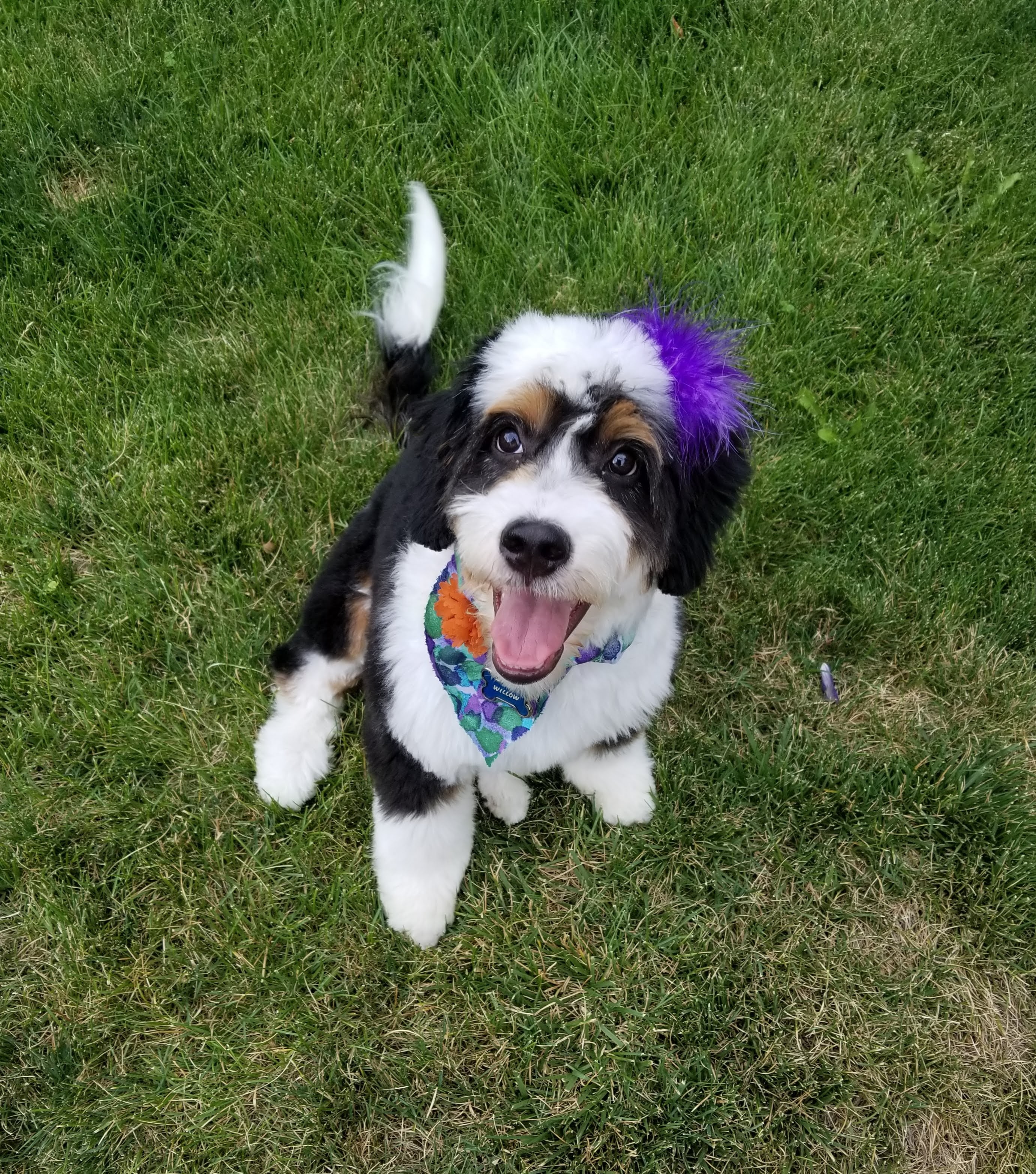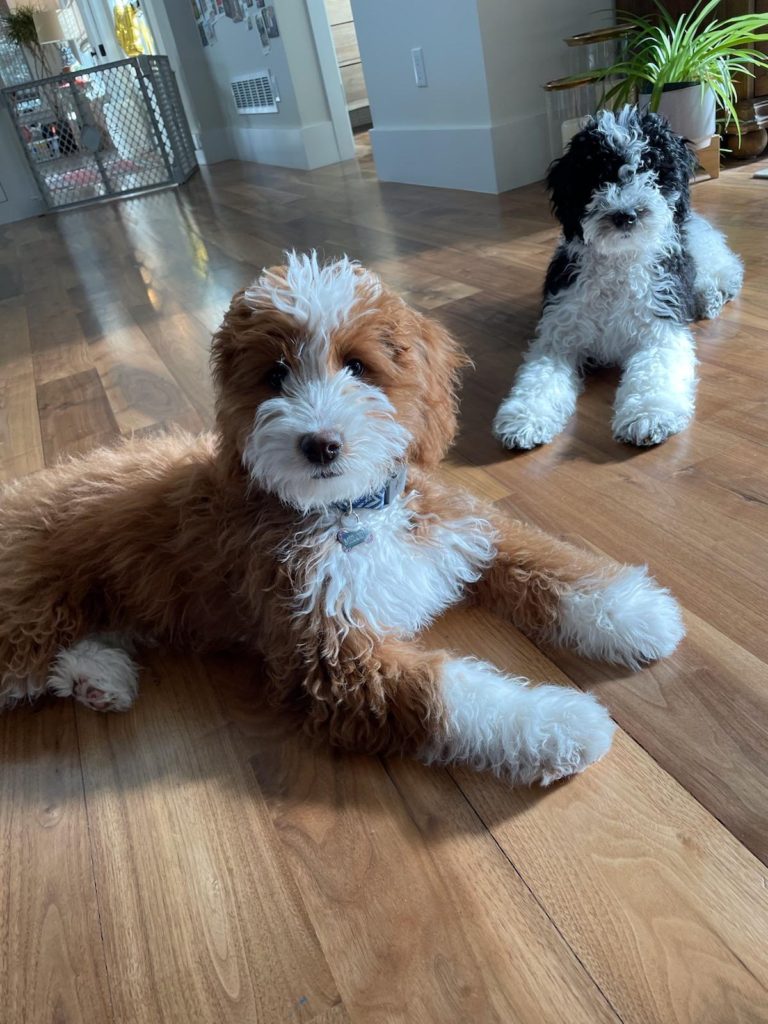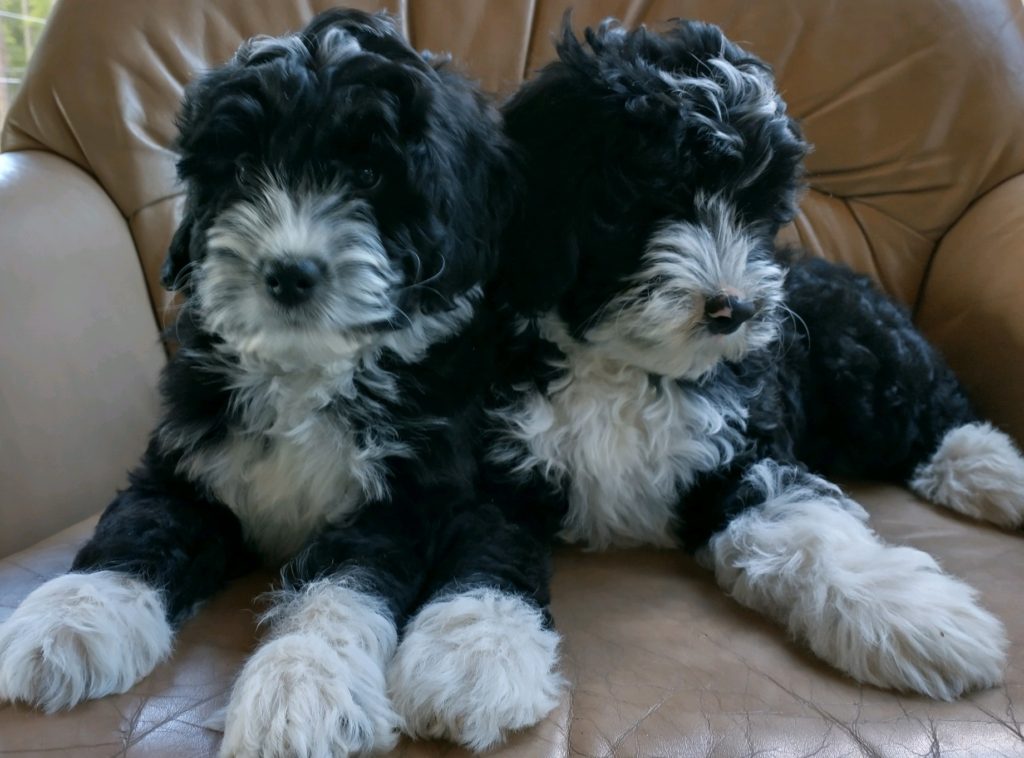Do Bernedoodles shed?
Like most doodle variations, Bernedoodles are typcially low shedding. Some may not shed at all, depending on their Poodle ratio. For example, first generation (F1) Bernedoodles are half Bernese Mountain Dog and half Poodle, so they would be considered low shedding. A miniature Bernedoodle (F1b) with 75% Poodle and 25% Berner are likely not to shed. In short, it comes down to the Poodle math… the higher the Poodle concentration, the less the dog will shed.
Are Bernedoodles hypoallergenic?
In a word, no. Truth be told, there is no such thing as a “hypoallergenic” dog. There are only non-shedding dogs. That said, even non-shedding dogs produce dander, which can result in allergies. People can also experience allergies from the proteins in a dog’s saliva, which can manifest as a contact dermatitis or hives. If you are nervous about whether or not you might be allergic to dog dander or dog saliva, hang out with a friend’s dog and ask him for hugs and kisses. If you have a reaction to either, now you know. This method is much more efficient that going through with bringing a puppy home only to find out that you are, in fact, allergic to dogs and find you need to return your puppy.
Is it a good idea to take my puppy to a dog park for socialization?
Would you allow your infant to play on the floor of a NYC subway station? Absolutely not. It is a terrible idea. While your puppy has had their first set of vaccinations at 8 weeks of age, the series will not be completed until they receive their third set at 16 weeks of age. Your puppy will not be protected until after both the Da2PP series and the rabies vaccinations have been given. Puppies can acquire germs and bacteria through the pads on their paws and through their noses. That makes places like dog parks, pet stores, designated potty areas, groomers and veterinarian offices unsafe for unprotected puppies. Most groomers and vet offices disinfect routinely because they are well aware of this risk, but they are not responsible for whether the dogs who visit their places of business are all up to date on their vaccinations.
Viruses like Distemper and Parvovirus are extremely dangerous and potentially lethal for puppies. The germs that cause these viruses can be carried around on the soles of shoes and brought into the home, putting a puppy’s life at risk. This is why we exercise high level hygiene practices for visitors on Go Home Day. Soles of shoes will be disinfected, disposable booties will be worn, and hands will be washed with soap and water. Chances are, if you are about to bring home a puppy, you’ve been to the pet store to stock up on all the things for your new baby. We take these measures to avoid any potential cross contaminations.
How can I socialize my puppy before 16 weeks?
While it is true that your puppy will not be fully vaccinated until they are 16 weeks old, that does not mean they need to be kept inside and isolated from the world for that whole time. There are certain small windows of opportunity in a dog’s life where their future behavior can be heavily influenced. The first three months of life are critical. We begin introducing scents to puppies when they are 3 days old, and continue with a new scent each day through the 16th day. Smell is the first sense that is awake after birth, so we use this time to grow and challenge their brain. During this time, days 3 – 16, we do ENS (Early Neurological Stimulation) to help give our puppies a healthy edge in life. Around 3 weeks old, we start to introduce inanimate novel objects to puppies, things that are round or square or shiny. From there we move forward slowly with new objects for them to explore, all while in the safety of their whelping box. Willow Tails puppies are well on their way to being properly socialized before they go home, and have been exposed to all sorts of sights and smells, household and train sounds, music, other dogs barking, doorbells, etc. They are also very accustomed to being handled, from the minute they are born and we dry them off, help them find mama to nurse, rearrange them while we change bedding and disinfect, bath time, daily as they grow, until the day we hand them to their new owners. This helps them to be touch tolerant, a joy for your groomer or vet to work with, easy going with children, and most of all balanced.
Things to do to socialize your puppy:
- Riding in a car (reduce fear and desensitize to motion and propensity to be carsick)
- Seeing bicycles, runners or people on skates going by (people should not have round legs… it’s weird)
- People with walkers, wheelchairs or crutches (again… wheels, and being on crutches looks like person has three legs)
- Children (we work on touch tolerance to aid in this)
- Wind blowing (So. Many. Smells.)
- Lawn mowers (loud sounds, mowers eat grass, not puppies)
- Vacuums and brooms (brooms are not attacking for no reason; vacuums are loud and have a super weird smell – first sense!)
- Plastic bags or balloons (random unexpected movement; balloons smell funny, make a distinct sound when rubbed together, resemble disembodied heads, and when they pop… FEAR)
- Seeing cars and trucks drive by (they are moving by, not trying to attack)
- People watching at a mall (all shapes, sizes, smells… people are nice)
- Elevators (floors moving, beeping, weird smells – desensitize!)
- Different surfaces like shiny floors, cobble stones, gravel, wobbly surfaces
- Height – similar to the grooming table or vet
- Rain or sprinklers, garden hose (water can smell weird, barometric change can be scary. Try to make exposures to water fun)
- Banging pots and pans (desensitize to abrupt loud noises)
- Other dogs or pets (supervise play, do not allow bullying)
- Hats, masks (do not force interaction, make it a positive experience)
- Umbrellas (open one, set on the floor, let puppy investigate and learn there is nothing to fear)
*Find what motivates your puppy (toys or high value treats) and reward your puppy for calm relaxed behavior. Exposing and desensitizing puppies to these things and making them a positive experience can prevent phobias in your adult dog.
How often should a Bernedoodle be groomed?
It really depends on their coat. Some will have more of a flat, wavy coat and others will have a tighter, curly coat. Those with wavy coats can go longer between grooms but will also tend to shed some. Curly coated doodles will need to be brushed regularly and professionally groomed every 12 to 16 weeks or so. Curlier coats can tend to mat if not taken care of properly. Should you bring a matted doodle to your groomer, be prepared to pick up a “noodle” (AKA naked doodle) at the end of the appointment. If you aren’t familiar with doodle side eye, you will most likely experience it on your way home!
Also, please refrain from allowing your dog’s ears to be plucked – it is a common practice for groomers to pull the hair out of the inner ears by the roots. It is about as fun as it sounds. Yes, doodles with curlier poodle coats can have quite a bit of hair inside their ears, and it can get yeasty and infected if it gets wet. But plucked ears can be very sensitive, prone to infection and irritation, and can cause your doodle to become “head shy” at the groomer or vet. Trim the hair if it is needed, keep them dry, but if the ears get irritated and itchy, we recommend using Zymox 0.5% Hydrocortisone ear solution.
Is it easier to train a male or a female?
Now, this is a gross generalization, but males do tend to be easier to train. Males tend to be more affectionate, bond easily with their humans, and just a little more laid back. Females tend to bond to one human in particular, be more independent and have a bit of a stubborn streak. Stubborness is a Berner trait, so they can come by it naturally. The key to training Bernedoodles is gentle consistency. They do not require firm correction. Another Berner trait is nervousness around new people or environments. This is a good example of why socializing puppies and working them through nerve strength curriculum is so important.
If you have young children, a male might be the best choice to fit into your family dynamic. The best way I can describe the difference in temperament and trainability between males and females is this… if you have children, and have raised daughters, then this will make perfect sense.
What colors do Bernedoodles come in?
Most people can identify Bernedoodles by the tri-color (black, white and brown) pattern they share with their parent breed. But Bernedoodles can come in solid black, black and white (Tuxedo), tri-phantom (black with tan socks and points at the eyebrows), and a few other fun variations. The tri-color seems to be the most coveted color pattern, but is actually quite difficult to produce consistently. There are many, many genetic coat trait combinations that determine which colors/patterns puppies will have. Often there will be a few different color patterns in the same litter. Each litter, especially with different parent pairings, is like a box of chocolates… you never know what you’re gonna get. No two Bernedoodles will look exactly the same. Personally, I love all the possible color combinations! Health and temperament are far more important to me than the wrapper they come in.





